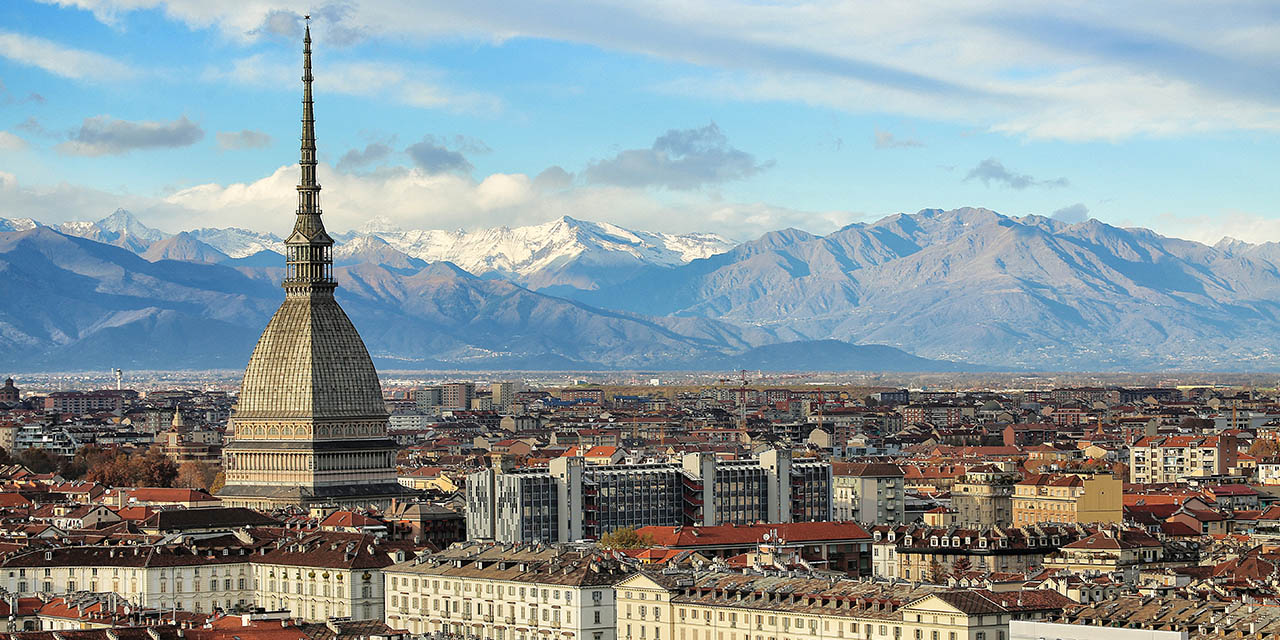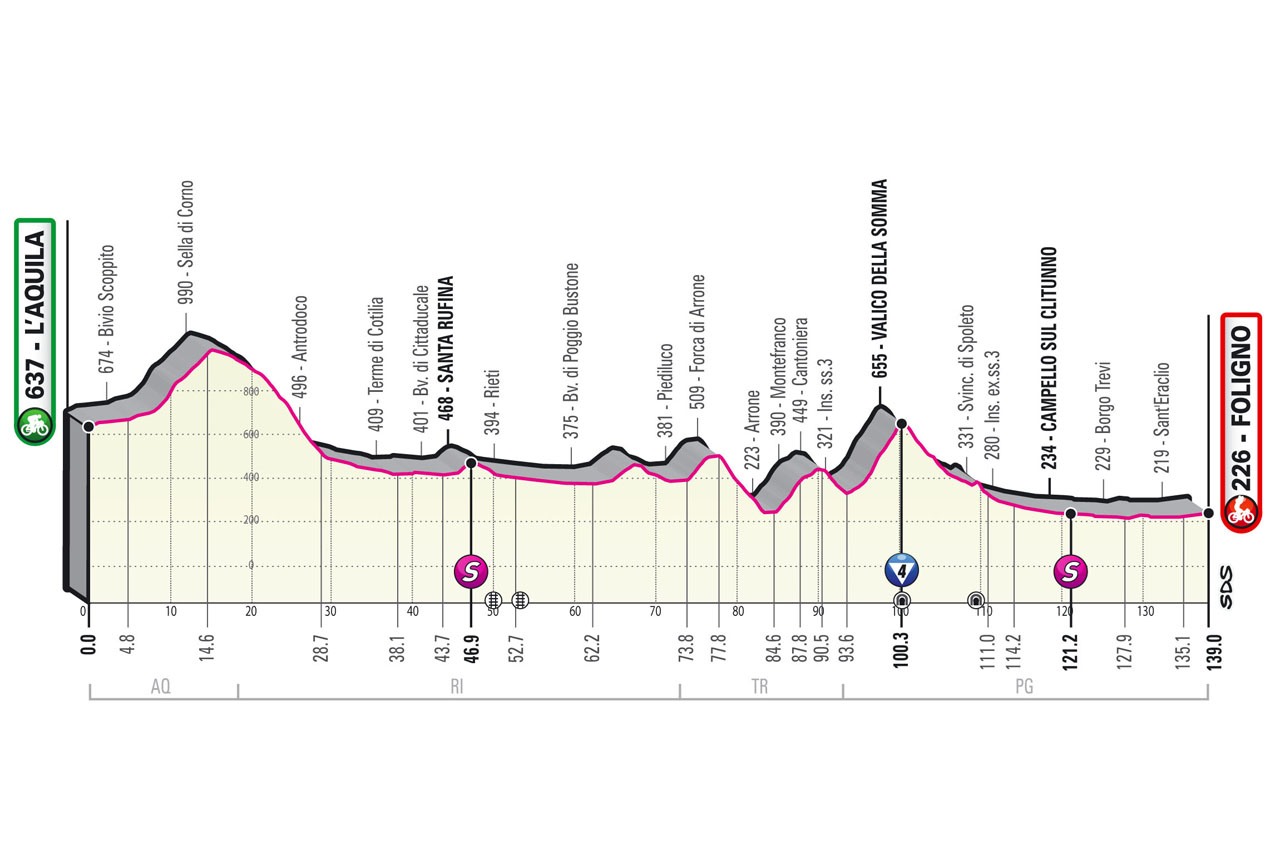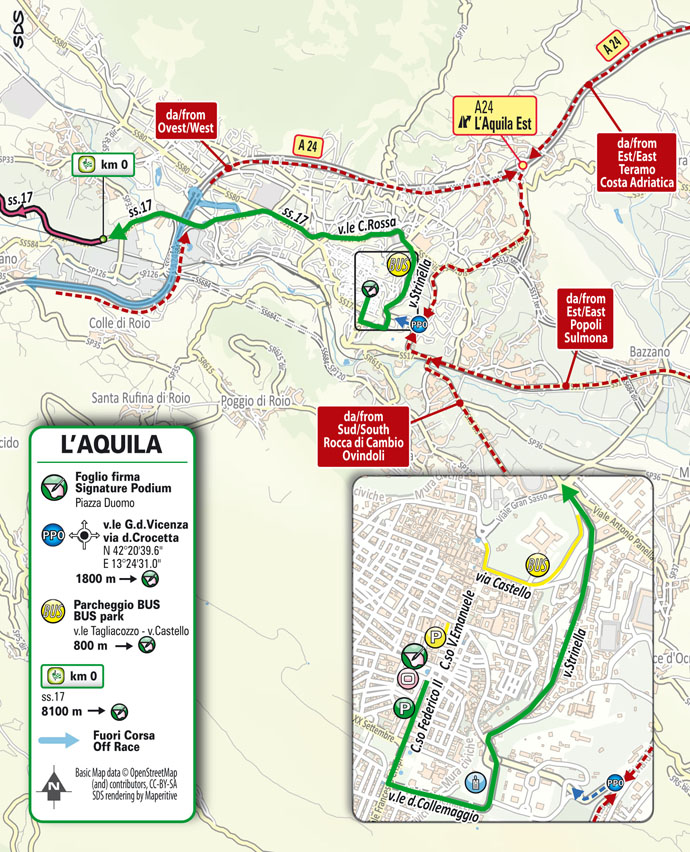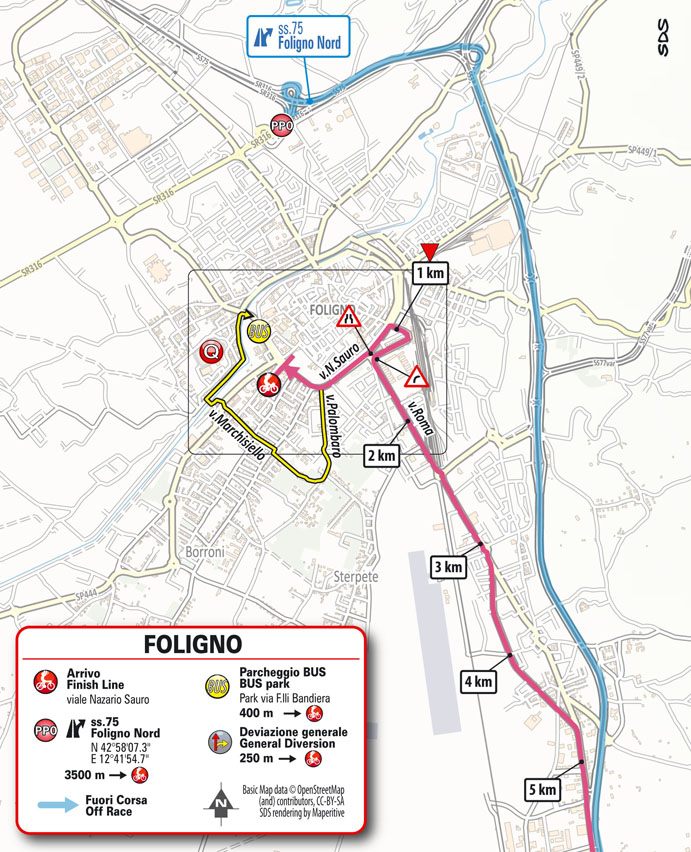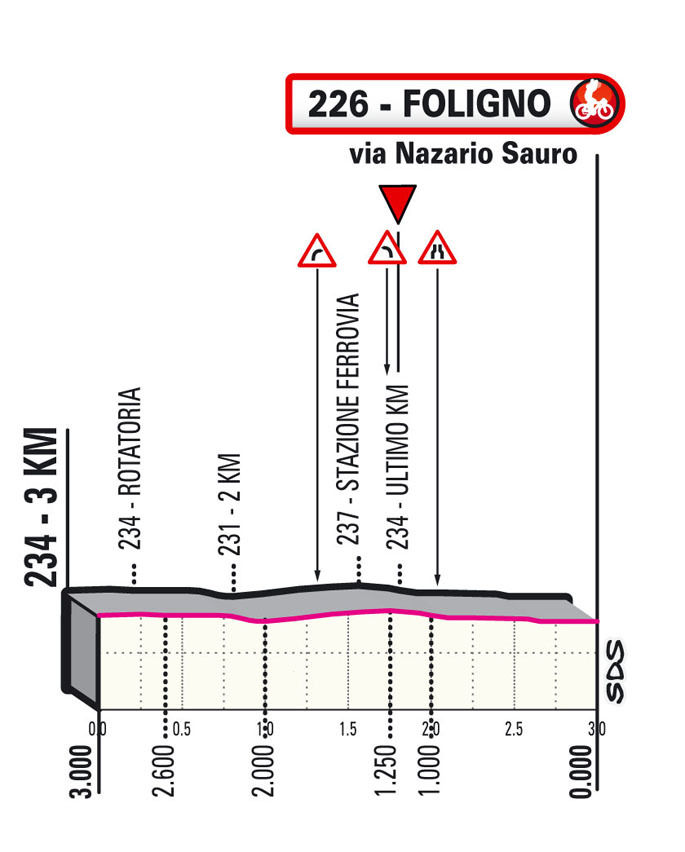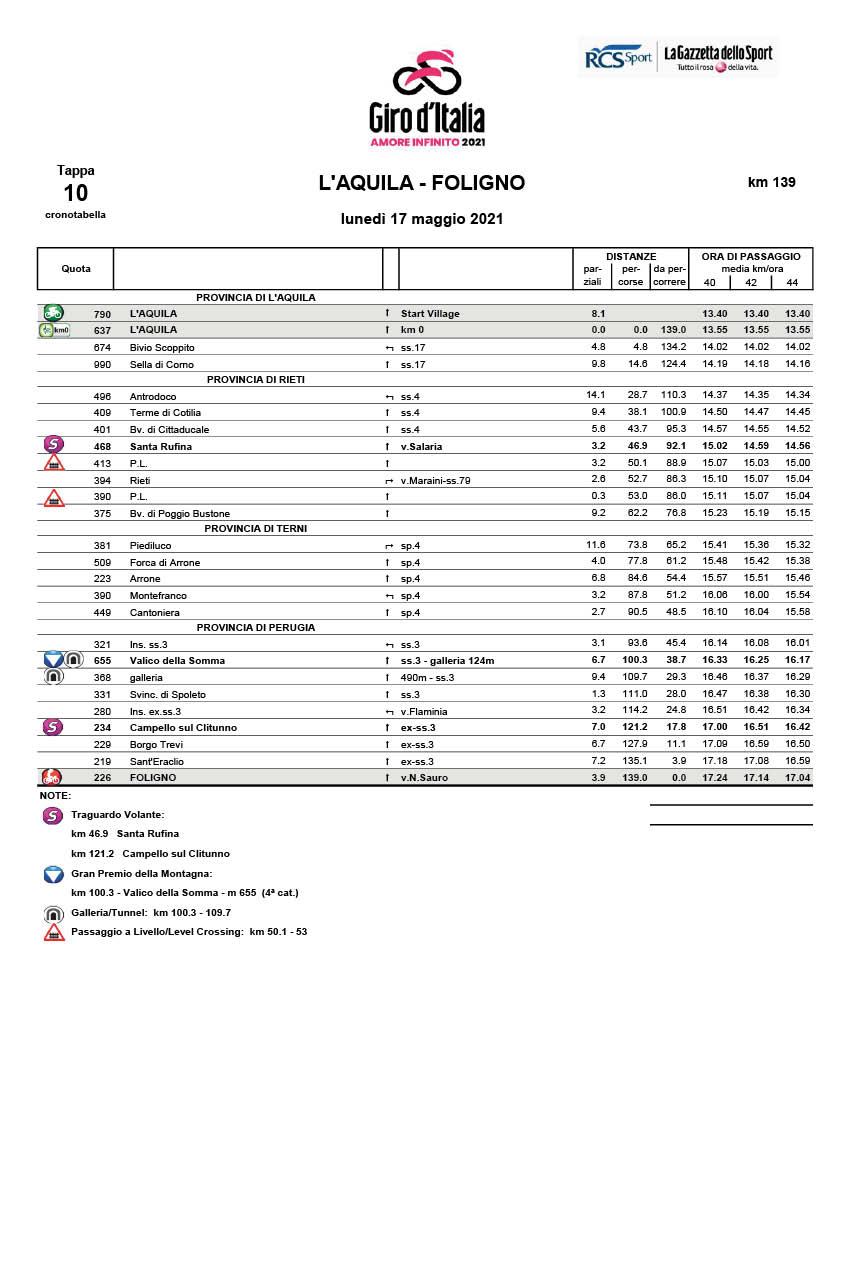profile
map
technical info
A short, rolling stage with a pan-flat finale. The route first takes in climbs up to Sella di Corno and Forca di Arrone, and then tackles one last ascent up to Valico della Somma (awarding KOM points). The route eventually levels out in the final part, running on broad and mostly straight roads. As the stage passes through several urban areas, roundabouts, traffic islands and street furniture will be found along the route.
Final kilometres
The final kilometres are quite straight, up to 2,000 m to the finish. Here the route features a right-hand bend, immediately followed by two left-hand bends that lead to the home stretch (at 1,300 m out), with just a slight half-turn 500 m before the finish line, on tarmac road.
start / finish
final kilometres
itinerary timetable
tourist info
Host city:
L'Aquila
Overview
L’Aquila (means the eagle) is the capital city of Abruzzo region, placed at 714 m of altitude. The city is situated on a hillside in the Aterno river’s valley and it is surrounded by the Appenini mountains, with the highest peak Gran Sasso d’Italia (2.912 m) to the North-east. The city was founded by four villages locaded on the peak of mountain that embrace the city – locals called them Quattro Quarti. Founded in 1259 by the peoples of many castles, supposing ninght-nine, dotted around the cultivated basin of the Aterno River. L’Aquila was built with an unusual layout of the city: the area was divided such that each castle received a piece of land knows as a locale. The city prospered due to its wool industry and the sale of saffron, ensuring a rich artistic and cultural period.
Speciality food
The Aquilan cuisine is renowned for its taste and simplicity. Many of its dishes originated in the surrounding countryside. Leguminous soups are the specialty of the Aquilian housewives. Home-made taccozzelle with lentils and pasta and ceci. Fresh and dry mozzarellas, mountain ricotta and homemade cheeses. Excellent sausages, among which are those made from liver, called Cigolane and finally the Sanguinaccio, made with blood.
The lamb and pork, which is roasted, barbecued or stewed. Mutton, called castrato, is easy to find at the beginning of spring, and above all, one must try the Arrosticini. Little pieces of sheep strung on a skewer, barbecued on an open fire.
Drinks
Each dish should be accompanied by a good Montepulciano d’Abruzzo red wine. Other noble wine is called Cerasuolo Aquilano, popular pink wine from Abruzzo. Traditional sweets recipes are more elaborate. The famous Torrone (nougat) is made with chocolate, hazel-nuts, honey and a taste of cinnamon. Biscuits, called Ferratelle, are also typical of the area and are hand-made with a decorated iron.
Main sights
The façade of the Basilica of Santa Maria di Collemaggio is one of the symbols of the city, characterized by the double coloured, white and pink stone of the Genzano di Sassa marble, and the majestic central rose window with two smaller lateral rosettes and the classic square structure, typical of the churches in Aquila. The beautiful façade became a part of history in 2009, when it remained unscathed by the terrible earthquake (april 6th), despite the interior was severely damaged by the disastrous collapse of the transept and the apse. Built outside the walls by Pietro da Morrone in 1288, legend has it that Pope Celestine V was crowned here in 1294. The Basilica is located at the point of arrival and departure of the Great Trail, from L’Aquila to Foggia, which over the centuries has been traversed by thousands of flocks of sheep and cattle during the period of transhumance. The Holy Door is on the left side of the basilica. It is opened once a year on the occasion of the Perdonanza Celestiniana (the annual jubilee of L’Aquila announced by pope Santo Celestino V). Pardon is granted to those who are repentant and who have confessed by crossing the Holy door between the evening of 28th and 29th August. Next to Collemaggio, into Parco del Sole, there is the Amphisculpture, on of most important project of land art, ever created in Italy, by american artist Beverly Pepper. An outdoor theater of 3000 square meters, 1800 seats, the largest in central-southern Italy.
The Fontana delle 99 cannelle is one of the key monument of the city, was built in the place where the city was founded. The fountain is framed on three sides by a tall wall with a white and pink checkerboard pattern. A row of 99 different grotesque marks, each with its owns spout, spurt water into the trought below, which then filter into a series of lower troughs. Hence a single fountain with 99 spouts representing the castles that participated in the foundation.
Piazza Duomo (13th cen) is one of the largest medieval squares in central – southern Italy. In the lower part of the square there is the Duomo church (13th), Basilica of San Massimo and San Giorgio. The most important architecture on the Piazza is to be found in the church of Santa Maria del Suffragio, named church of Anime Sante, construction in 1713 from drawings by Carlo Buratti, a pupil of Carlo Fontana. During the earthquake of 2009 the couple collapsed on live tv. The church was one of symbol of tragedy, today inside the church, totally rebuilt, is conserved the memory-record of 309 earthquake’s victims. In this square there are two fountain, with large basis and two bronze male statues, they called the old fountains, built in 1930 made by the sculptor Nicola D’Antino. All the city, after the earthquake, is been rebuilt by the modernest technique. L’Aquila has become a beautiful tourist city and a school of good technical and engineering practices of reconstruction, famous all over the world. The Emiciclo, seat of the Abruzzo Regional Council, is an example of radical reconstruction and improvement project. A long work of restoration and safety, carried out with the most advanced engineering techniques with installation of seismic isolators below the whole colonnade. The Emiciclo is now one of the most popular places in the city and is dedicated to hosting concerts and events, both in the interior and on the outer square, embellished every evening by spectacular coloured lights that enhance the charm of the colonnade.
Foligno
Overview
Located along the Via Flaminia – one of the main roads leading to Rome – the ancient Fulginium, currently Foligno has a rich history and culture, along with plenty of culinary traditions. It sure deserves a visit to please your eyes, clear your mind and treat your taste buds.
Lying halfway between the more renowned Perugia and Assisi, the city is an excellent destination, all round. Strategically located as a major road and railway hub, the city expanded repeatedly over time, and even grew outside the old town centre in the modern age, towards the surrounding plains. The original oval shape, now lost in the tangled web of the suburbs, can still be seen from the hills, when descending from Montefalco, or along the Menotre river valley. Wide tree-lined avenues lead from the four cardinal points to the city gates, Porta Romana and Porta Todi, woven together by the ancient city walls. River Topino flows to the north, while one of its inner branches passes through some of the most picturesque parts of the city that were the seat of ancient production facilities. There are gardens just outside the walls, and lovely piazzas within. Major landmarks include the Neoclassical-Baroque cathedral (named after the patron saint of the city), the Town Hall (with the iconic features of a 13-century building), Palazzo Trinci (with its stunning Gothic staircase), Palazzo Orfini (named after the typographer who printed the first Italian edition of the Divine Comedy) and its amazing 16-century gate, and Piazza della Repubblica, the beating heart of the city.
Foligno – the third largest city in Umbria – is now a lively trade hub, with a population of approx. 60,000.
Speciality food
Local cuisine offers a wealth of traditional Umbrian delicacies such as legume soups (especially grass pea), bruschette topped with olive oil, fresh handmade pasta (such as strangozzi and pappardelle) seasoned with wild game sauce or truffle, lamb roast and the famous coratella. Local specialties also include the iconic pizza al formaggio (cheese bread) and its sweet rendition, made for Easter. When it comes to cakes, rocciata is a must-taste. This local rendition of the strudel, richer and tastier, is best paired with a glass of fine Sagrantino wine. Typical local produce include Colfiorito red-skinned potatoes, whose sweet and fragrant yellow flesh is used for making gnocchi, or cooked in embers.
Main sights
Palazzo Trinci (XIV secolo), Cattedrale di San Feliciano (XII-XIX secolo), Abbazia benedettina di Sassovivo (XI secolo), Museo della Stampa (Palazzo Orfini, XVI-XVII secolo), Calamita Cosmica di Gino de Dominicis (Arte contemporanea, chiesa SS Trinità), Parco di Colfiorito (Area naturale protetta), Valle del Menotre (Pale e Rasiglia).











